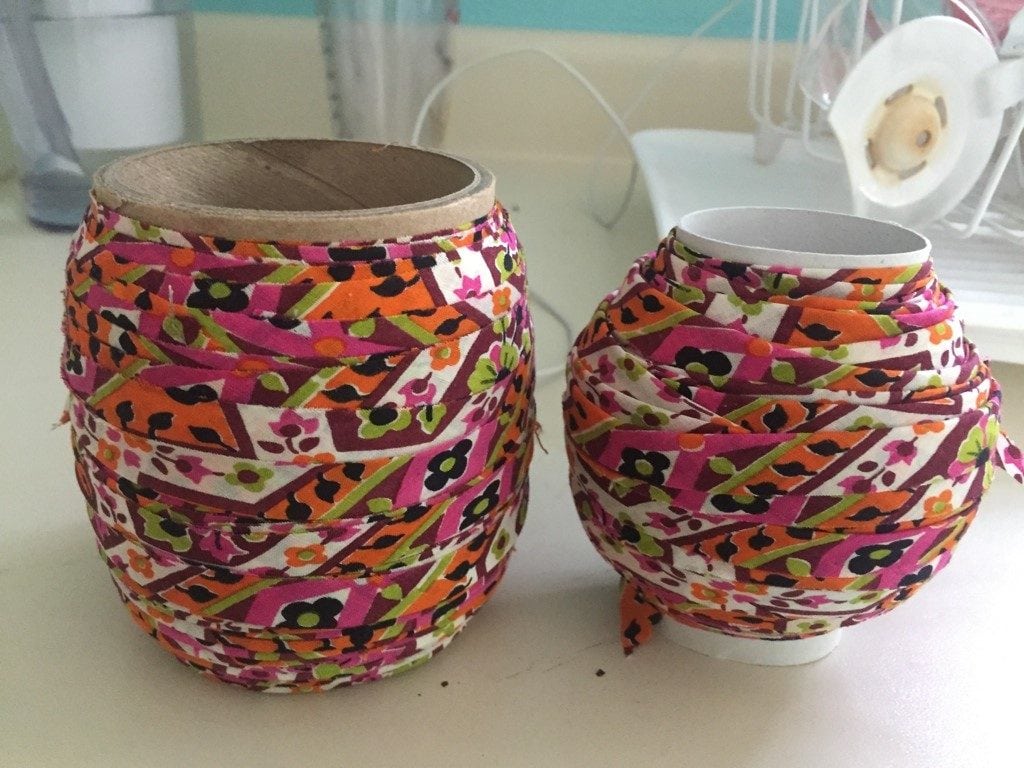A Legacy Rag Runner
Designed by Nancy Nowak
Good things come from spending time with fellow weavers. We share finished projects, newly discovered tools and toys, and honest critiques. Our lively conversations inspire, motivate, and nudge us into trying new structures and unusual materials.
Last year, one of my fellow guild members shared a scarf she’d woven with weft from silk fabric “harvested” from thrift store blouses. Her project stimulated conversation among several of us about what materials we might find in our own closets to repurpose as weft. A friend confessed that for many years, she had held on to a 70s-era maxi-dress sewn with a colorful cotton lawn fabric. Her dress carried too many memories to give away but was honestly too dated to ever wear again. As I coaxed her to at least consider the weaving possibilities her vintage dress presented, she offered the dress to me.

I guess she knew I loved a challenge.
I wove this project on my 4-shaft Baby Wolf. Coincidentally, the dress that became weft for my table runner was gifted to me by the original owner of my Baby Wolf. Meaningful connections seem to abound when you’re a weaver!
Using unusual materials in our weaving offers opportunities for creativity, and repurposing abandoned items in our closet—or those of our friends—is a particularly satisfying adventure. While outcomes are less predictable, giving new life to old textiles connects us to weavers of the past who made do with materials at hand to create functional, beautiful pieces. I wonder what you can find hiding in your closet just waiting to be transformed.
What You'll Need
-
Warp and tabby weft: 8/2 unmercerized cotton
-
Pattern weft: 1” wide bias-cut fabric strips
-
4-shaft Baby Wolf
Materials
Equipment
Directions
Unsure of exactly what I do with my treasure, I carefully removed the stitching from the seams to maximize the dimensions of the available fabric. Using a rotary cutter, a 24ʺ x 5ʺ transparent ruler marked in 1ʺ increments (widthwise), and a very large rotary cutting mat, I cut the fabric into 1ʺ bias strips. I sewed the shorter strips together to create strip lengths 2–3 yards long, and then folded the strips in half horizontally, rolling the folded strips tightly onto cardboard tubes for storage.

Fabric strips are a wonderful weft option for an overshot project. If you cut fabric on the bias, there’s no need to enclose the raw edges of the fabric inside a fold. To showcase the unusual colors in my fabric, I settled on a simple overshot pattern that Robert Hils had introduced in a weaving class at Southwest School of Art in San Antonio. The draft required a thick (pattern) weft—perfect for my repurposed fabric strips—alternating with a thin (tabby) weft. I estimated that I had enough yardage to weave a decent-sized table runner.
After interviewing various colors from my stash for the warp, I settled on black 8/2 unmercerized cotton. I used this same yarn as the tabby (thin) weft for the overshot pattern and for weaving 1-1/2ʺ hems in plain weave at the beginning and end of the runner.
Weaving tip: I did not use a shuttle for the fabric strips; I simply placed them into the shed and slightly overlapped adjoining strips to minimize bulk. Because my strips were cut on the bias, there are very few pesky threads peeking out of the pattern in the finished table runner.
After taking the project off the loom, I secured the woven ends with a machine-sewn zigzag stitch before hand-stitching the hems (1/2ʺ fold, made twice to enclose the raw edge). To wet-finish, I soaked the runner in warm water for several hours, rolled it in a towel to remove excess moisture, and then laid the runner flat to dry. After it was dried, I snipped any trailing threads or fabric ends that bothered me.
Notes
Nancy Stein Nowak is a retired federal judge. A wife, mother, lawyer, teacher, sewer, knitter, weaver, spinner, gardener, hiker and camper, she is happiest making things and giving them away. She lives in San Antonio.

